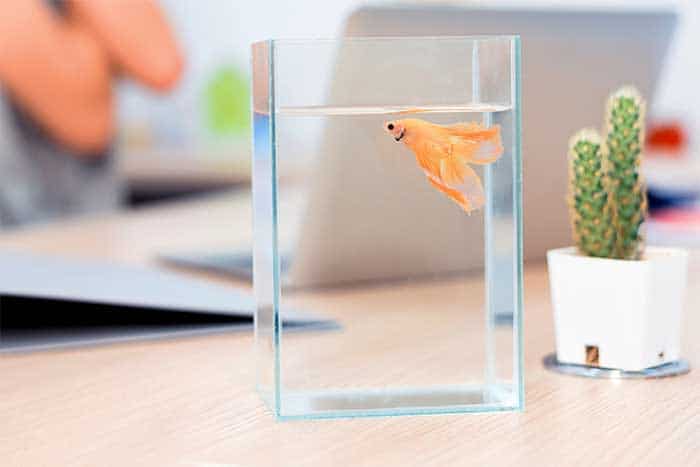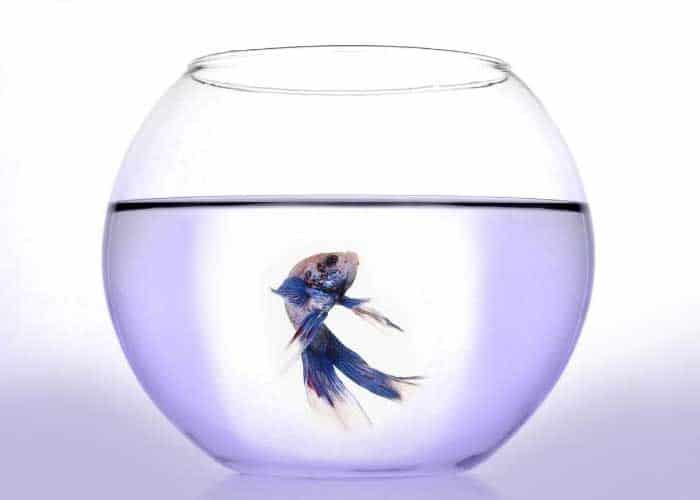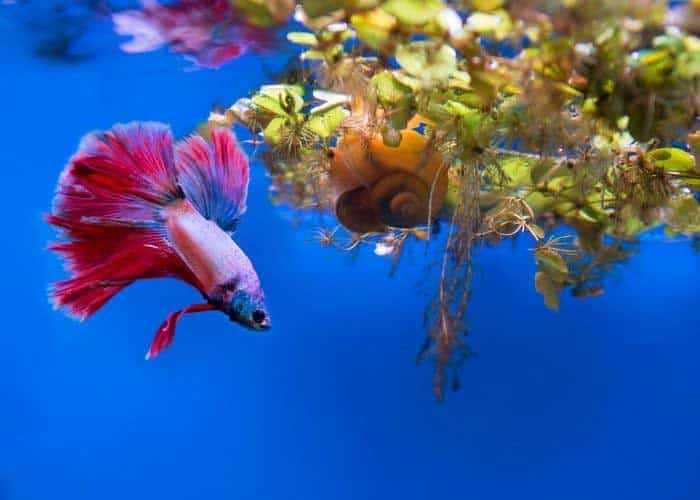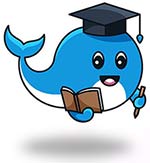How Big Should A Betta Fish Tank Be (For optimal health)
When it comes to keeping a Betta fish, one of the most common questions people have is how big should a betta fish tank be. The size of the tank depends on several factors, including how many fish you plan to keep and how much space you have.
A betta fish tank should have a capacity of 10 gallons or larger. It’s a common misconception that betta fish are happy living in tiny spaces such as small bowls or vases, and they have become a popular decorative pet in many homes. Small spaces lead to stress, and poor health, reducing a bettas lifespan.

If you are looking to set up a betta tank, there are many things to consider, with tank size at the top of the list. So let’s delve a little deeper and answer the question, how big should a betta fish tank be, and why?
What Is The Minimum Tank Size For Betta Fish?
A 3 gallon betta tank is the minimum you should consider buying for a single betta fish. 3 gallons provides enough room to swim and has space for a filter and heater.
Betta fish can live in smaller tanks, but they are not ideal. Small tanks often do not have enough room for a filter and heater, leading to poor water quality and fluctuating water temperatures.
It is also important to note that small tanks tend to be more difficult to maintain as they can quickly swing from one extreme to the other. Ammonia and nitrite levels can rise rapidly in small tanks, which can be very dangerous for your fish. You need to be careful how often you feed your betta and how much, to monitor waste levels.
The myth that betta fish live in small spaces is due to a misunderstanding about their natural habitat, so what has started this unhealthy trend?
A Bettas Natural Habitat
You can find betta fish in many parts of Southeast Asia, often in the rice fields that are plagued with dry weather in the warmer months and flooding during the rainy months.
When the rice fields are flooded, betta fish can move freely through large expanses of water, although the dry season reduces this large body of water into small puddles, where the misunderstanding starts.
The assumption that betta fish live in these small puddles for many months has sparked the trend of keeping bettas fish in small ornamental vases and tiny tanks. Still, these puddles are not entirely disconnected, allowing the betta to swim from smaller puddles to larger puddles.
Betta fish are quite unusual as they can breathe out of the water through a unique organ known as the labyrinth organ, which acts like a human lung. This unique ability allows betta fish to jump and wriggle across the land until they find larger puddles and sources of water.
You can read more about a betta’s natural habitat here: Betta Fish Care For Beginners.
How Much Room Does A Betta Fish Need?
How much room a betta fish needs depends on the tank setup. If you plan to house your betta with other fish, you need at least a 10 or 20 gallon tank. If you plan to keep your betta by itself, a 3 gallon tank will be fine, but a 5 gallon tank would be better. Neither is ideal in the long term as they don’t provide much room to swim freely.
While betta fish are mostly sedentary creatures that do not require a lot of space to swim, over time, they can become stressed in a small environment. You will often find your betta fish hiding, so you should provide plenty of plants and other hiding places to help them feel secure.
What Kind Of Tank Does A Betta Fish Need?
Although betta fish don’t need lots of space, they are curious creatures and like to explore their surroundings, and larger tanks provide more room for your fish to swim and explore.
Betta fish typically prefer shallower, wider tanks that provide the necessary room to swim. Betta fish are very territorial, so the larger the perceived space, the easier it is for a betta to find some territory. A taller betta fish tank can feel relatively confined, with less room to swim.
Betta fish are also happier in short tanks, similar to the natural environment in which they are found.
What Happens If Your Tank Is Too Small For Your Betta Fish?
A tank that is too small for your betta fish can cause several problems. Poor water quality is the most common problem associated with small tanks. Your betta water should be clean and at its best, or you risk a multitude of problems occurring.
As betta fish produce waste, the ammonia levels in the water start to rise, which can be very dangerous for your fish. Ammonia poisoning can cause serious health problems such as lethargy, loss of appetite, and even death.

Beneficial bacteria will usually control ammonia by feeding on it and converting it into less harmful nitrates. If the tank is small, the waste produced by your betta fish may be too much for the number of beneficial bacteria within the tank.
Other problems that can occur if your tank is too small for your betta fish are:
- Fluctuating water temperatures
- Not enough oxygen in the water
- Stressful environment for your fish
- Lack of filtration
- Stunted Growth
- Your betta fish jumping out of the tank.
It is much harder to maintain any level of consistency in a small tank, as small bodies of water tend to fluctuate quickly in quality and temperature.
One example of temperature is comparing a cup of coffee to a water tank. A cup of coffee, when left to sit, will become cold quickly, whereas a large water tank of heated water remains warm throughout the day.
If you have a betta tank heater, this won’t be a problem as the water temperature will remain stable, but you should always have a spare heater in case of malfunction and check the water temperature often.
Small betta tanks often don’t have room for filters, and the lack of filtration can cause rapid fluctuations in water quality requiring regular testing and water changes.
Smaller tanks also contain less dissolved oxygen which can cause your betta to sit near the surface to breathe air from outside the tank. Although betta fish have this ability, it is not a good long-term solution as your betta can become stressed over time.
Small tanks are generally more stressful for your betta fish as they like to have their territory and space to hide from perceived threats. Even if your betta is the only fish in the tank, it may still feel restricted and sit in one spot for long periods as it can’t exercise or explore.
When a betta fish feels restricted, they often try to jump out of their tank. Jumping poses a real problem, especially if your tank doesn’t have a lid. A betta can jump high enough to clear the rim of their tank, so it can hurt itself when landing on the floor, or worse, it may not be found in time to save it.
Stress is a leading cause of many illnesses, such as fin rot. A small betta tank also allows other diseases and parasites to develop more quickly due to the difficulty of maintaining water conditions.
Below is a list of illnesses and conditions that you need to look out for:
- Betta Fin Rot – A bacterial infection often caused by poor water quality and stress.
- Betta White Spot (ich) – A parasitic infection often caused by poor water quality.
- Betta Stress Stripes – Not harmful but an indicator of stress in your betta.
- Betta Fin Clamping or Curling – Caused by fin damage, poor water quality, or stress.
- Velvet Disease – Caused by a parasitic infection.
- Dropsy – A bacterial infection sometimes from poor water quality.
- Betta Swim Bladder Disease – A symptom of an underlying condition such as a constipated betta. A common symptom of constipation and bloating in betta fish is if your betta is not eating.
Although you can find these illnesses in larger aquariums, the stress of a tiny tank can lead to a weak immune system and a more severe illness.
Everything I have listed, from low oxygen to stress, can also impact a bettas growth. For a betta to grow to full size, it needs the best water conditions and little or no stress.
Juvenile betta fish also release a growth-inhibiting hormone that is intended to stop other competing betta fish from growing too big, but in a small tank, your betta gets affected by its own growth-inhibiting hormones.
Why Are Large Tanks Better Than Small Tanks?
If you are stuck between choosing a large tank or a small tank, you should be pleased to know that there are many benefits to owning a large tank with very few pitfalls.
Large tanks are much easier to maintain than small tanks for several reasons, such as:
- More stable water quality
- Easier to keep warm
- Better filtration
- More oxygen in the water
- Less stress for your fish
Larger tanks have a more stable water quality as there’s more water to dilute the waste produced. The larger the tank, the less often you need to do water changes.
Tropical fish need a heater to keep warm, and water temperature is more consistent in a larger tank, requiring less energy to heat over time. If your heater fails, you have more options to keep the water heated to a suitable temperature until you can replace it.
Another benefit of a larger betta tank is the extra room for a good filter. Filters keep the water clean for longer, resulting in the water parameters remaining stable, requiring fewer water changes.
Big fish tanks generally have a larger surface area to help oxygen saturate the water efficiently. A filter, as mentioned above, also provides surface water agitation, helping oxygen to enter the water.

A final benefit of having a large betta tank is the added space for your betta fish to swim freely, and you can decorate it more easily with live plants and ornaments to make your betta happy. Live plants positively impact your fish tank’s overall health and will provide places for your betta to hide out, which ornaments also offer.
In short, the bigger your tank, the better for you and for your betta fish. So, how big of a tank does a betta fish need?
What Is The Best Tank Size For Betta Fish?
So far, we have looked at the minimum betta fish tank size and the benefits of large tanks over small tanks, but overall, What is the best tank size for betta fish?
A 20 gallon tank is an ideal betta fish tank size and provides enough room for a few small, compatible tank mates. Although 20 gallons is suitable, if you have room for a bigger tank, then go bigger. When it comes to tank size, bigger tanks are always better.
I have covered a multitude of tank sizes already, with the benefits and drawbacks of each, but many retailers stock a variety of tank sizes from huge to very small.
Although I can offer advice, it is not for me to tell you what size tank to get for your betta fish, so instead, I’ll look at some specific sizes below and briefly discuss the benefits and drawbacks of each.
Below is a useful video that I found on Youtube that shares many of my thoughts on choosing the right betta tank size.
1 Gallon Betta Tank
Although people go even smaller, 1 gallon betta tanks have become quite popular. Many 1 gallon fish tanks are available to buy with variations that can house several bettas at once.
Small 1 gallon betta tanks are often built for quirkiness and can look great in small spaces, which is ideal if you don’t have enough room for a large tank.
Despite their unusual designs and their small space requirements, in my opinion, such a small tank doesn’t allow your betta to enjoy a long and healthy life and is instead an excellent way to display your betta fish in the home without the work required to maintain a larger tank.
On the downside, small betta tanks require regular cleaning as waste can build up much more quickly, often having no filtration to remove it.
How Long Do Betta Fish Live In A 1 Gallon Tank?
Betta fish can live for over 5 years in a suitably sized tank, but if you keep your betta confined in a 1 gallon tank, it may only survive 2-3 years. I say survive because they are not really living the life that has been intended for them.
If you do want a 1 gallon tank for your betta, I recommend having a separate larger tank that you can transfer them into from time to time. I know some people who use small ornamental tanks throughout the day and have a nighttime tank.
Alternatively, you can use such a small tank for tiny fish or small shrimp, like ghost shrimp. Small fish won’t need as much swimming space and will not produce the same amount of waste as larger tropical fish can produce.
2 Gallon Betta Tank
My thoughts on a 2 gallon betta tank are similar to that of a 1 gallon tank. 2 gallons is approximately 7.5 liters which isn’t terrible and provides some room to swim, but a tank of this size is still challenging to maintain.
The water parameters in a 2 gallon betta tank need regular testing, you also need to keep the tank away from draughts or direct sunlight to keep the water temperature stable.
Many 2 gallon betta tanks are aimed at beginners or are designed to look good on a small shelf or desk. They are not usually as functional compared to a larger betta tank, with little space for a filter, a heater, or ornaments.
Some beginner tanks may have filtration and heating built into the tank housing, which would be beneficial.
3 Gallon Betta Tank
In my opinion, a 3 gallon betta tank is the absolute minimum size that you should aim for when keeping a betta fish.
Ideally, choose a broader tank to provide a larger surface area, helping oxygen saturate the water more easily and to provide more swimming space. Wider tanks are also easier to decorate with plants and ornaments, which give your betta somewhere to hide.
There are plenty of options when buying a betta fish tank in this size range, and many come as a complete aquarium kit that is perfect as a first betta tank.
If you can find a tank with a heater and filter built into the housing, it would provide even more swimming space in the tank.
5 Gallon Betta Tank
Similar to a 3 gallon tank, a 5 gallon betta fish tank is a popular choice among people with a little more room, and it provides almost double the swimming space. Although 5 gallons is not a big tank, your betta fish will feel quite comfortable in a tank of this size, and it should be easier to maintain than the smallest variants.
If you want to keep more fish with your betta, 5 gallons is not suitable, even for tiny fish like tetras. Too many fish in such a small tank can quickly play havoc with your water parameters, so it’s always best to over-filter and understock your tank.
You can add plenty of plants and some ornaments to a 5 gallon aquarium, undoubtedly making it look the part wherever you choose to situate it. The plants help bring natural bioactivity, meaning more oxygen, more beneficial bacteria, and more stable water parameters.
Once a tank creates some level of bioactivity, specific processes start to occur naturally, reducing the need for daily and sometimes even weekly water changes.
10 Gallon Betta Tank
A 10 gallon betta fish tank is becoming increasingly popular with more experienced hobbyists as it provides an excellent middle ground for size, price, and maintenance.
10 gallons gives your betta plenty of space to swim around in, and if you add some plants and ornaments, it will look impressive.
While a 10 gallon tank is not a large aquarium, it’s still 2-3 times the size of a standard betta fish bowl which makes all the difference. If you choose to add other fish to your tank, do your research first, as some fish are incompatible with bettas.
Male betta fish are not compatible with other male betta fish and should only be kept with female betta fish when you are looking to breed them. Because of the territorial nature of betta fish, they will likely become aggressive and want to fight each other.
You should not place larger fish such as cichlids, gouramis, and goldfish with bettas as they will often show aggression and invade your betta’s space, and a 10 gallon tank is not suitable for larger fish of this size.
As with all aquariums, the larger the tank, the easier it is to maintain. There’s more water to dilute ammonia and more space for beneficial bacteria to colonize.
20 Gallon Betta Tank
If you are keen to start fish-keeping as a full-time hobby and looking to buy a new tank, 20 gallons is the way to go. A 20 gallon tank gives you plenty of scope for fish choice and aquascaping, and if you are considering keeping other fish in the tank, there is plenty of room for your betta to hide away if it feels threatened.
Bigger tanks are much easier to maintain, and although a 20 gallon tank may be considered medium in size, it’s still much bigger than a standard betta fishbowl, and it will show in the quality of your water.
With a 20 gallon tank, you have plenty of options for stocking, and you can even add some larger fish, such as loaches and plecos.
As long as you do your research and make sure the fish are compatible, a 20 gallon tank can be a great way to get into fish keeping, and it will provide years of enjoyment.
Betta Sorority Tank Size
Although you should not keep male bettas together, it is possible to keep small groups of female betta fish together, which is called a betta sorority tank. Betta sororities can be challenging, but if you have a group of female betta fish that get along, it can be quite rewarding and is ideal for breeders.
Female betta fish are not as territorial as their male counterparts, but they will need their own space, with plenty of plants and other decor to separate them.
The minimum tank size for a betta sorority depends on the sorority size. A 20 gallon tank can successfully house 3 to 5 female betta fish, although a bigger tank can increase your chances of success.
Best Betta Fish Tanks (Beginner Friendly)
If you want to buy a betta fish tank, the choice can be pretty overwhelming. Because of the popularity of betta fish, many manufacturers now make tanks specifically designed for them. Many pet stores stock a wide variety of these tanks, and they are often the popular choice for beginners.
Despite being designed for betta fish, some manufacturers don’t consider the ethical size requirements or the general function of the tanks they put on sale, so you can often find yourself with a great-looking tank with minimal benefit.
When choosing a tank for your betta fish, I suggest looking around and comparing functionality. Ensure that there is suitable heating, lighting, and filtering, which you can easily replace should they malfunction.
Providing good betta fish care starts with your choice of tank, so don’t be sold on a tank just because it has been labeled as a betta fish tank, especially when there may be other more suitable and cheaper tanks available.
Because I understand the difficulties when shopping for your first betta tank, I have provided a list below of my favorite choices. The listed tanks vary in size but are the best betta fish tanks that I have had experience with and are suitable for new and experienced fish keepers.
Also, if you are worried that your betta fish may get lonely or bored by itself and feel you need to get a larger tank to add more fish, have a quick read of my article: Do Betta Fish Get Lonely Or Bored On Their Own?
BiOrb Classic 8 Gallon Led Aquarium
GloFish 5 Gallon Aquarium Kit
Coralife BioCube 32 Gallon Aquarium
Fluval Edge 12 Gallon Aquarium
Marina Led Beginner Aquarium Kit – 20 Gallon
All of the aquariums listed above are complete kits and would be the best option for beginner aquarists to set up. They should provide most of the equipment that you will need, such as internal filters and heaters, and you may find that some will add gravel to the kit.
Conclusion
I hope this article has provided you with enough information on how big a betta fish tank should be. If you are considering keeping betta fish or looking to upgrade your current tank, I highly recommend a 20 gallon tank or bigger, which gives you plenty of space to add other fish and makes tank maintenance much easier.
The absolute minimum size tank should be 3 gallons. If you want your betta to remain healthy, live longer, and have a happy life, you need to aim for bigger.












